Architect / Director of Kyoto City Museum (Commonly used name: Kyoto City KYOCERA Museum of Art). Born in 1956 in Yokohama, Japan and graduated from Tokyo University with a Master of Architecture in 1982. Established his own eponymous practice, Jun Aoki and Associates (re-organized as AS in 2020) in 1991. Architectural Institute of Japan Annual Award by Fukushima Lagoon Museum in 1999, and by Kyoto City Museum in 2021. Minister of Education’s Art Encouragement Prize in 2005. Professor of Tokyo University of the Arts.
Installation view “Medium and Dimension: Liminal” Kakinokisou (2022) (Foreground, center) Madoka Furuhashi, When rotten reeds begin to glow, 2022 (Right) Hirofumi Isoya, Auxiliary Line, 2018-2020 (Left) Nozomi Suzuki, Other Days, Other Eyes: Windows from the East Side of the Room 102 of the Kakinoki Apartment, 2022 (Far end, center) Kazuaki Yamane, Reform, 2022 (Far end, to the right [column]) Nao Osada, Room number sign (#104 Kakinokisou, Tokyo), 2022 (Far end, to the right) Akiko/Masako Takada, Back and forth, 2022 Photo by Takaaki Akaishi
A forest under reconstruction
Curated by Takuya Nakao, the exhibition “Medium and Dimension: Liminal” was held at Kakinokisou in Kagurazaka, Tokyo from September 3 to 27, 2022. The 12 exhibiting artists (individuals or pairs) were Hirofumi Isoya, Nao Osada, Yusuke Kamata, Kota Sasaki, Nozomi Suzuki, Akiko and Masako Takada, Takuro Tamayama, Michiko Tsuda, Norimichi Hirakawa, Naoya Hirata, Madoka Furuhashi, and Kazuaki Yamane.

Installation view “Medium and Dimension: Liminal” Kakinokisou (2022) Akiko/Masako Takada, (Left) The lapse of time, 2022, (Center) Inside out, 2022, (Right) Broom, 2022 (Center [pillar]) Nao Osada, affixed postage stamp (21Kč), 2022 Photo by Takaaki Akaishi
The Kakinokisou house is a so-called mokuchin, the kind of two-story wooden apartment building that was standard in Japan at the time of its completion in 1966, and since 2016 has been used mainly as an artist-in-residence facility. The building was to be renovated for a new use, with most of the partition walls of its 12 apartments to be removed and the walls and ceilings stripped to create a large, cohesive space. The exhibition was held in the midst of this renovation, in a space where the walls were covered only with plasterboard and with the mortar surface visible on the ground floor.
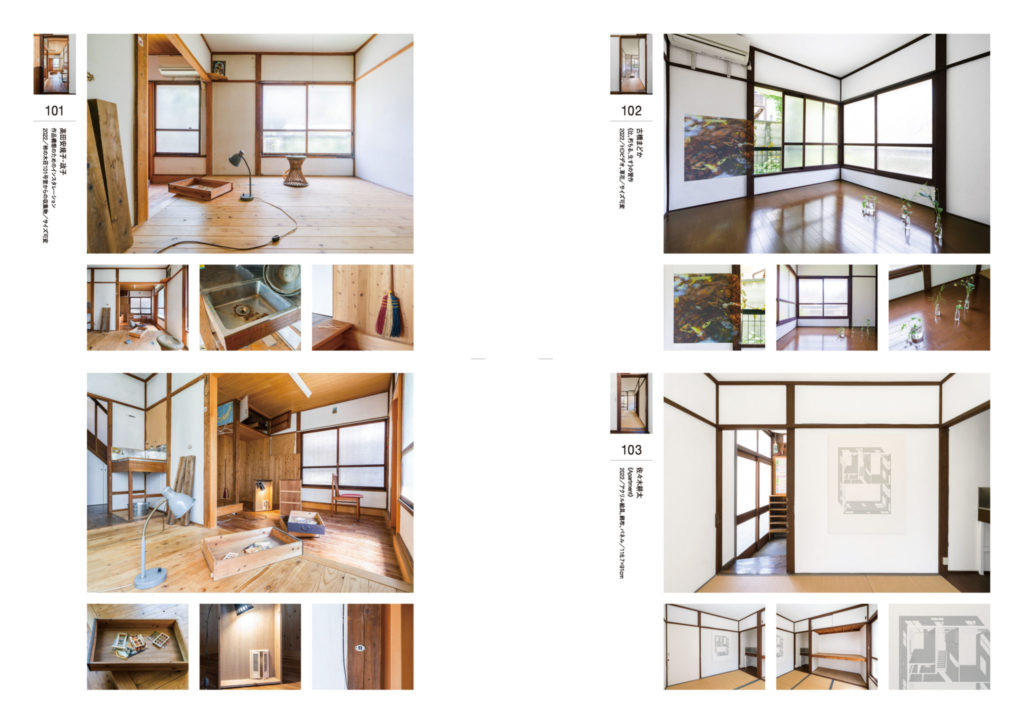
Guidebook “Liminal” Book design: Takuya Nakao Design: Hirokazu Matsuda Photo by Takaaki Akaishi
The guidebook distributed to visitors featured both the Kakinokisou building’s floor plan before the renovation and the floor plan at the time of the exhibition. It also included photographs of the artwork displays. However, these photos had been taken before the renovation began, when the 12 exhibiting artists had placed their works in each of the 12 apartment rooms. The images show that each artist attempted a different exhibit in their respective room, as if they were residents of the building. What visitors actually saw, however, was a scene in which the artworks had been scattered throughout the building, as the partition walls between the rooms had been removed. Many viewers peered into their guidebooks while moving around the exhibition site, looking to see the gaps that lay about the space.
In this sense, the exhibition made for an experience that could not be completed by viewing it in the present, as it extended beyond any spatially or temporally limited time-space. The space was in transition, and time was also moving back and forth between at least two periods: before renovation, and after the floor plan had been changed. The most significant feature of the exhibition was that it occupied an elusive time-space—the “under construction” period between pre- and post-renovation phases.

Installation view “Medium and Dimension: Liminal” Kakinokisou (2022) (Left) Nozomi Suzuki, Other Days, Other Eyes: Windows from the East Side of the Room 101 of the Kakinoki Apartment, 2022 (Right) Madoka Furuhashi, When rotten reeds begin to glow, 2022 Photo by Takaaki Akaishi
In fact, the space under construction created an unsettling, somehow half-hearted atmosphere. While it did retain elements that could evoke nostalgia for the Showa period, the quality of the space was canceled out by the ubiquitous presence of construction materials waiting for finishing touches to be applied. When a work of art is exhibited in an austere, unreliable space, the work itself appears in an ambivalent form, as if it is neither autonomously generating space nor depending on its environment, or vice versa, being autonomous but simultaneously derived from its surroundings. It could be said that a third relationship between space and artwork was being tested here—one that differed from both the dynamics of exhibitions in “white cube” spaces and those of site-specific exhibitions that draw on the characteristics of a given space.
If their environment is fluid rather than fixed, artworks must also oscillate, displace, transform, and mutate. In any case, all environments are in motion. For example, even a forest that appears to be in a state of permanence in fact demonstrates an equilibrium reached through the natural transition of vegetation; it is an extreme phase that maintains its stationary state through movement. Even more so, artificially constructed cities are continually changing in scale and organization as they are redeveloped and rearranged, while buildings are repainted, their damaged parts are replaced with new ones, their use is changed, and they are extended or diminished according to the exigencies of the times. Assuming that an artist is conscious of this fact, the relationship between artworks and their environment cannot be a fixed one, but rather resembles an ecosystem in which the environment and works interfere with each other, with the environment influencing the works and the works impacting on their environment. This is what I mean with a third relationship between space and artworks.
Then, in such a configuration, what kind of specific interactions resonated within the venue? That’s the crux of this exhibition. To illustrate, I will only touch on part of what was happening in the large exhibition space at the back of the second floor.
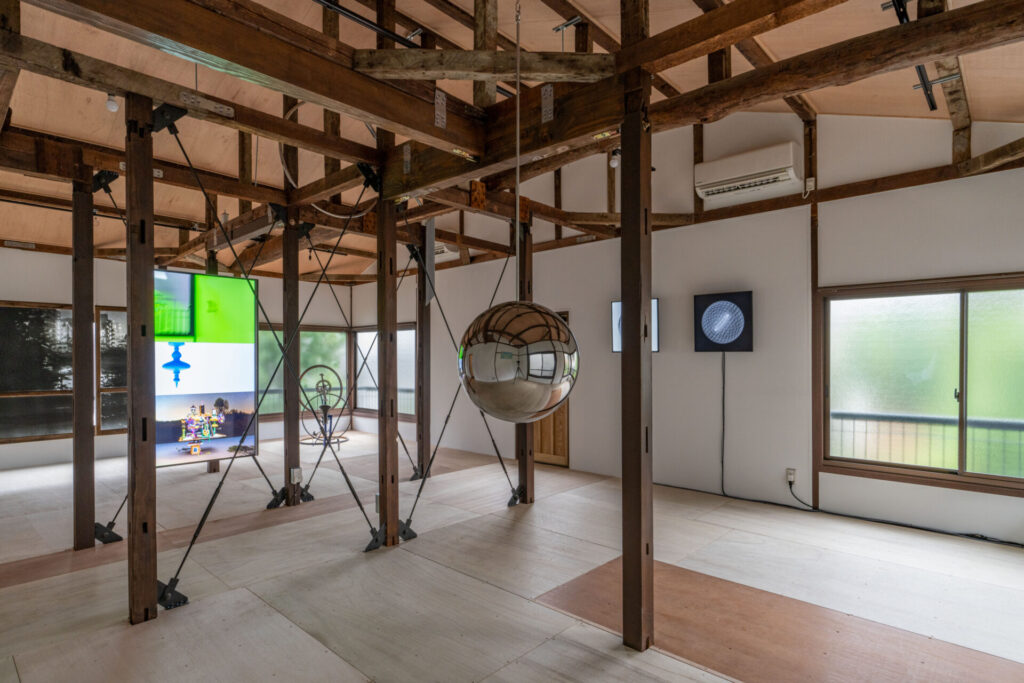
Installation view “Medium and Dimension: Liminal” Kakinokisou (2022) (Far end, to the left) Nozomi Suzuki, Other Days, Other Eyes: Windows from the East Side of the Second Floor of the Kakinoki Apartment (Night), 2022 (Left) Naoya Hirata, Old Time Machine 434, 2022 (Far end, center) Kazuaki Yamane, Reform, 2013 Takuro Tamayama, (Center [beam]) Spinning Mop (Silver Hair), 2022, (Foreground, center) M.B., 2022 (Right) Norimichi Hirakawa, S³ [hyperspherical coordinates], S³ [hopf coordinates], 2019 Photo by Takaaki Akaishi
Before the renovation, said second-floor space consisted of four-and-a-half tatami-mat rooms, two to the east/two to the west of a hallway. The walls between the rooms and the hallway were removed, the ceiling was stripped, and the space was in the process of being converted into one large room. The first aspect of this change in environment is, of course, that the space was no longer divided into small rooms, but another is that the removal of the ceiling exposed the beams and roof framing, with the beam lattice above the line of sight now defining the entire space.
Naoya Hirata and Takuro Tamayama seemed to be sensitive to this change.
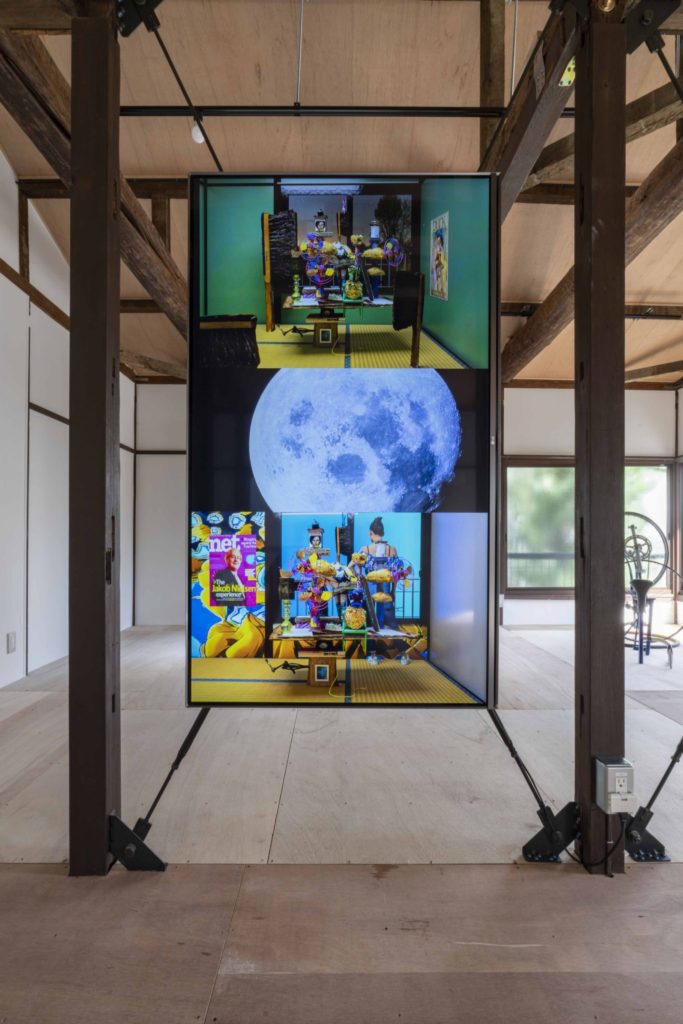
Installation view “Medium and Dimension: Liminal” Kakinokisou (2022) (Left) Naoya Hirata, Old Time Machine 434, 2022 (Right) Kazuaki Yamane, Reform, 2013 Photo by Takaaki Akaishi
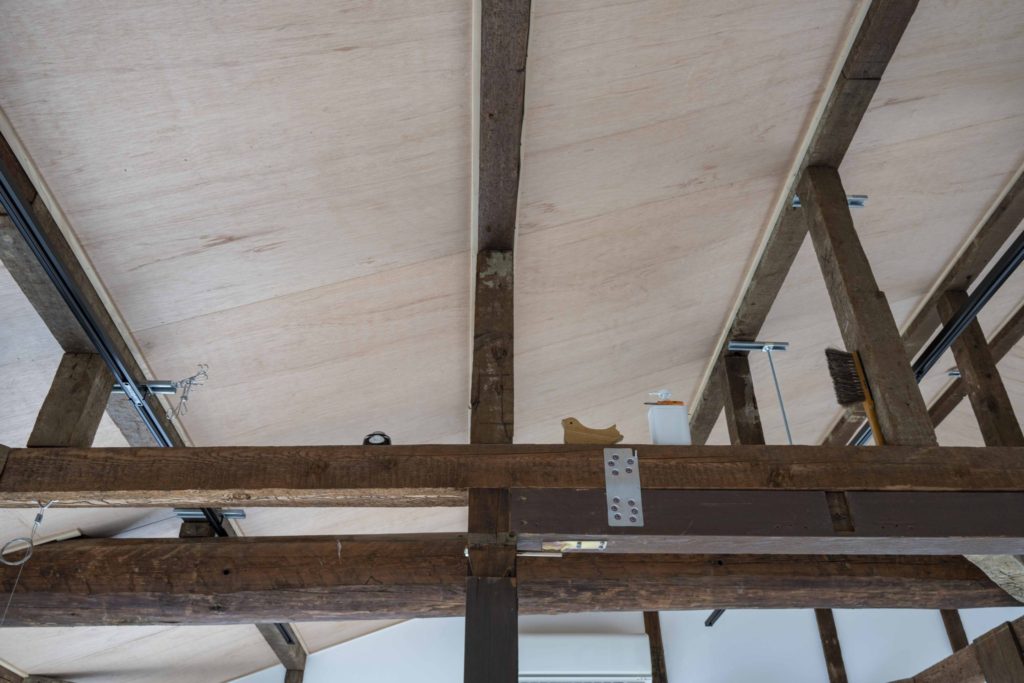
Installation view “Medium and Dimension: Liminal” Kakinokisou (2022) Naoya Hirata, ‘Items collected from the former Room #203 of Kakinokisou’ Photo by Takaaki Akaishi
In the middle of the four-and-a-half-mat room allocated to him before the renovation, Naoya Hirata had stacked small objects collected in Kakinokisou on top of each other, placing them in the center of the tatami. During the course of the renovation, he created a digital representation of these items and then reassembled the resulting images in a virtual space, playing them on a large monitor attached to a reinforced-concrete brace used for structural support, while moving the actual objects on top of the beams. These small objects spread out on the beam lattice, such as three clips attached to metal fittings that held a lighting duct in place, revealed that two worlds—one real and one imaginary—were developing underneath and above the beam lattice.
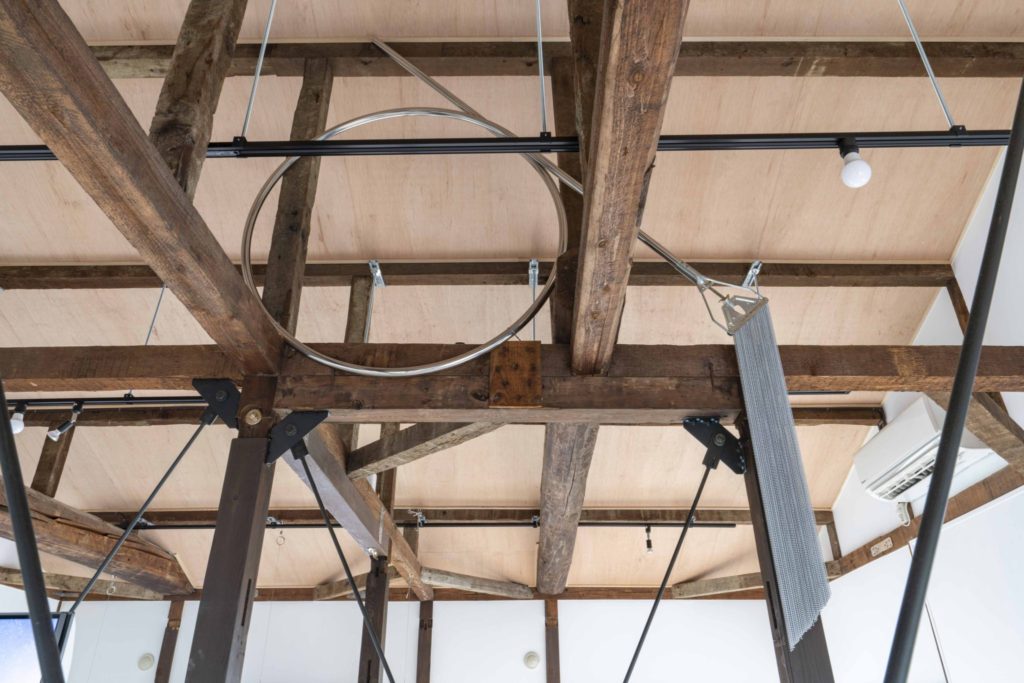
Installation view “Medium and Dimension: Liminal” Kakinokisou (2022) Takuro Tamayama, Spinning Mop (Silver Hair), 2022 Photo by Takaaki Akaishi
As the focal point of the newly emerging space, Takuro Tamayama created a structure of metal pipe ring and a mop around the upper beam lattice, which was originally above the hallway. The tassels of the mop hung down by gravity at the same width as the columns, forming a vertical line alongside the columns. The ring and mop handle cooperated with each other to bring about such a state, and were intertwined with the beam latticework and roof frames. This feature was not part of Tamayama’s exhibit before the renovation.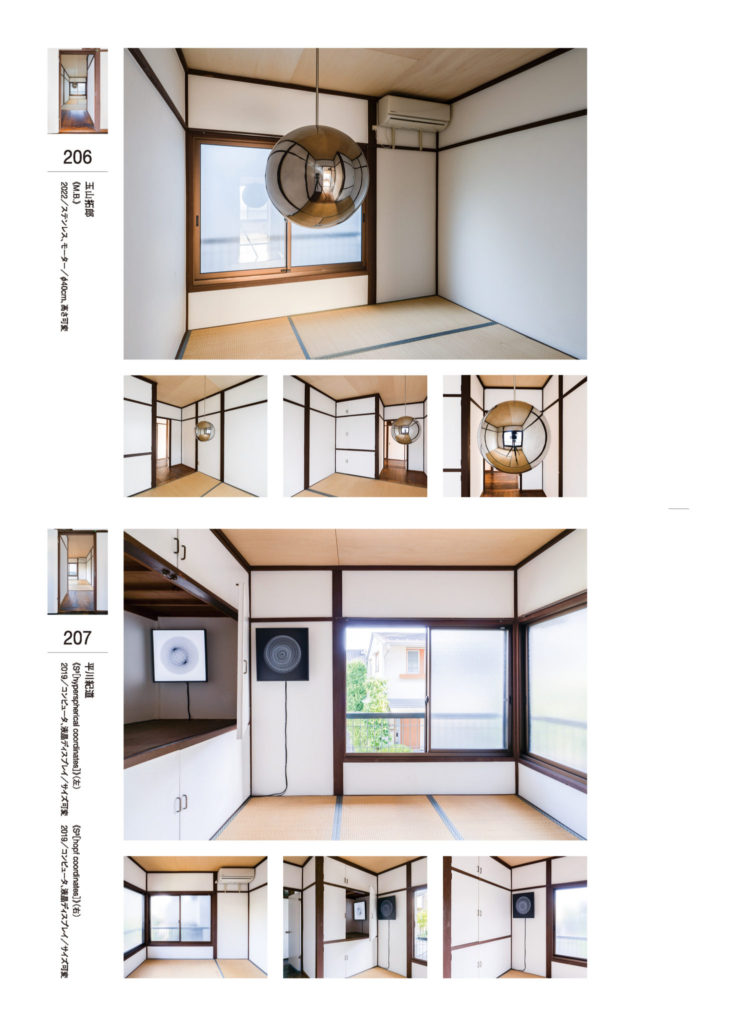
Guidebook “Liminal” Book design: Takuya Nakao Design: Hirokazu Matsuda Photo by Takaaki Akaishi
Before the renovation, Tamayama hung a spherical mirror in the middle of the four-and-a-half-mat room. Because it was in the very center of the space, the mirror reflected the appearance of the rectangular space surrounding it, distorted, but not overturned. The sphere captured the real space around it, including the people peering into it, as an imaginary space. The sphere was rotating slowly. When the viewer notices the rotation, the imaginary space of the mirror image disappears and the real space of the rotating sphere emerges. Here, as in Hirata’s work, the theme is the parallel between real and imaginary spaces. From the viewpoint of the room, the space is absorbed with the sphere in the center as the focal point. From the standpoint of the sphere, the space on the sphere is projected onto its surroundings and materialized. The imaginary and the real were equally alternated.
During the renovation, Tamayama retained the position of his sphere. The only thing that changed was the surrounding environment. The sphere was no longer in the center of any space. Because of this, the composition of the work shifted. The mirror sphere, as an entity, was foregrounded. This corresponded to the moon in Hirata’s video. It corresponded to the white wire frame of Norimichi Hirakawa’s black and white spherical shape writhing on two square monitors. The work created a new web of context.

Installation view “Medium and Dimension: Liminal” Kakinokisou (2022) Kazuaki Yamane, Reform, 2013 Photo by Takaaki Akaishi
The focus of the space was no longer on the mirror sphere, but on the structure created by Tamayama in the beam lattice and roof frame. On the opposite side of Tamayama’s sphere in the diagonal direction, centering on it, was Kazuaki Yamane’s three-dimensional sculpture: a bicycle broken down into its parts and reconstructed. Contrary to Tamayama’s centripetal sphere, it is a diffuse object. To emphasize the correspondence between the two poles, a ring of metal pipe, which could be mistaken for a bicycle wheel, was entangled in the beam lattice and roof frame.

Installation view “Medium and Dimension: Liminal” Kakinokisou (2022) (Far end, to the left) Kazuaki Yamane, Reform, 2013 Takuro Tamayama, (Center [beam]) Spinning Mop (Silver Hair), 2022, (Center) M.B., 2022 (Right) Norimichi Hirakawa, S³ [hyperspherical coordinates], S³ [hopf coordinates], 2019 Photo by Takaaki Akaishi
The autonomous subject matter of the alternation of imaginary and real is maintained. It becomes the life force embedded in the works, responding to its environment and renewing it. In this way, the boundary between the works and their environment blurs. A forest, an ecosystem, comes into view.
Twelve mycelia, each with its own DNA, extend their tentacles and intertwine with the ever-transitioning trees, a dynamic organism that mutually invades its constituent parts. That was the vision conjured up by the “Medium and Dimension: Liminal” exhibition.
Translated by Ilmari Saarinen
INFORMATION
Medium and Dimension: Liminal
Date: 2022.9.3 - 9.27
Venue: Kakinokisou (Tokyo)
Organized by
Curated by Takuya Nakao









